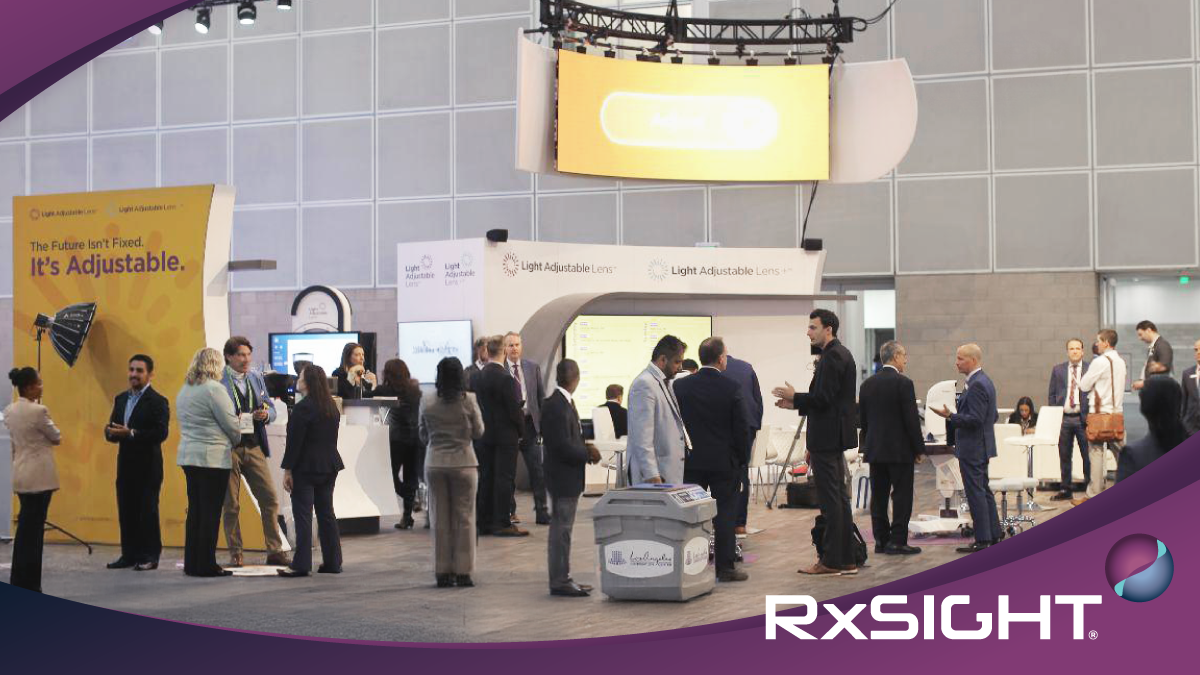Sponsored by RxSight®
Experts highlight real-world applications of the Light Adjustable Lens™ (LAL®/LAL+®) for optimized cataract outcomes.
On Day 3 of the 2025 American Society of Cataract and Refractive Surgery Annual Meeting (ASCRS 2025) in Los Angeles, the RxSight (California, USA) booth drew a crowd with a lineup of expert-led talks focused on the Light Adjustable Lens. From clinical applications and patient selection tips to marketing and workflow strategies, attendees got a well-rounded look at how this game-changing technology is being used in real-world practices.
LAL or LAL+?
Dr. Neda Nikpoor from Jenkins Eye Care (Hawaii, USA) shared practical guidance on selecting between the LAL and LAL+ for different patient types.
“The beauty of the Light Adjustable Lens is that it is the lens that gives us the ability to customize vision for our patients,” she said, pointing out how the technology helps separate the decision of surgery from the pressure of picking a final refractive target right away.
Drawing from post-marketing data (1,057 LAL and 407 LAL+ patients), Dr. Nikpoor showed both versions delivered excellent uncorrected distance vision: better than 20/20 binocularly on average.
Another benefit? The LAL+ needed less anisometropia. “We pushed 0.91 diopters mean of anisometropia versus 1.1 diopters of anisometropia in the LAL patients,” she explained.
For patient selection, Dr. Nikpoor offered practical guidance. “For somebody you would put a monofocal lens in, that’s a great patient to do an LAL in,” she advised. “If there’s somebody that you would feel comfortable putting an extended-depth-of-focus lens in—normal anatomy, minimal ocular surface disease, no significant macular degeneration or glaucoma, not post-refractive—then that would be a good person for an LAL+.”
The LAL+ is also ideal for patients new to vision optimized at different distances, since it delivers range without heavily inducing anisometropia.
Dr. Nikpoor illustrated her approach with two cases: one, a high myope who did well with the LAL; the other, an optometrist who initially planned for near vision, but after experiencing the LAL+, chose distance in both eyes instead. The result? 20/10 vision and one very happy patient.
“Even somebody who really, really knows—just doesn’t know,” she concluded, emphasizing the value of post-operative adjustability.
Bring patients in… and keeping them
To round out the session, Christine Sykora, practice administrator at Advanced Eye Care (Illinois, USA), shared strategies for attracting and converting premium lens patients.
“We’ve heard a lot about how to optimize patient vision once the lens has been implanted. But we have to get the patients to the office and through that decision process first,” she began. With acquisition costs ranging from $250 to $500 per patient, every touchpoint matters.
Today’s cataract patients are changing. They’re younger, more digital savvy and more informed. “Seventy percent of these patients are beginning their searches for healthcare providers online. And actually 92% believe that reviews are used as much as personal recommendation,” she noted.
Ms. Sykora emphasized a strong online presence (especially Google Business Profiles), a modern, mobile-responsive website and consistent branding. But once they’re in the door, the in-office experience can make or break it.
“Why are patients not choosing us? It’s not because of our competition. It’s not because they didn’t like what we had to offer. It’s because of the behavior of one person in our practice driving them away,” she stated bluntly.
To combat this, Ms. Sykora’s practice focuses on a unified “premium patient experience,” aligning language across all team members. “If the doctor is calling it a single distance lens, we call it a single distance lens. If the doctor calls it an adjustable lens, all of their materials need to say adjustable lens,” she explained.
Patient education starts early, with printed materials sent ahead of appointments and one-on-one sessions with a certified technician to handle the logistics, freeing up the surgeon to focus on outcomes.
Sykora also shared examples of their branded education folders, dry eye kits and post-op instruction packets. Regular audits, from tracking conversion rates to monitoring reviews, help keep the process sharp.
And it’s paying off. “Putting this process in place for our practice and the addition of RxSight lenses has moved our conversion of premium lenses from 20% to 33%, and it’s growing,” she reported.
More Light Adjustable Lens expert insights
Beyond the spotlight sessions, the RxSight booth also featured a diverse lineup of expert talks covering broader dimensions of Light Adjustable Lens integrations and outcomes.
Dr. Huck Holz of Kaiser Permanente (California, USA) shared insights on incorporating the Light Adjustable Lens into a large-scale integrated healthcare network, offering a systems-level look at making this technology work across multiple touchpoints.
Meanwhile, Dr. Alison Early, a cataract and refractive surgeon in Cincinnati (Ohio, USA) emphasized the importance of starting with the ocular surface, presenting tips on optimizing outcomes from the very first exam.
And for patients with complex visual demands, Dr. Christine Funke from Barnet Dulaney Perkins Eye Center (Arizona, USA) discussed how to fine-tune optical quality using Light Adjustable Lens technology, highlighting its adaptability in challenging cases.
The customizable future
The sessions at the RxSight booth offered a clear picture of where Light Adjustable Lens technology is headed: more customization, better patient outcomes and stronger practice integration.
As Dr. Nikpoor aptly summarized, “This is really the beauty of the adjustable lens—the fact that patients can test drive their vision, and you can really customize their vision in both eyes after implantation.”
With more than 1,044 practices and 1,850 surgeons now using Light Adjustable Lens technology in the United States—and over 225,000 lenses implanted to date—the shift toward adjustable vision is well underway.
Editor’s Note: Reporting for this story took place during the annual meeting of the American Society of Cataract and Refractive Surgery (ASCRS 2025) held from 25-28 April in Los Angeles, California, United States.
Reference
- Weikert MP. Spherical aberration and the Light Adjustable Lens. Presbyopia Physician. 2024;4:26-29.
INDICATIONS: The Light Adjustable Lens™ (LAL®) and Light Delivery Device™ (LDD™) system is indicated for the reduction of residual astigmatism to improve uncorrected visual acuity after removal of the cataractous natural lens by phacoemulsification and implantation of the intraocular lens in the capsular bag in adult patients with preexisting corneal astigmatism of ≥ 0.75 diopters and without preexisting macular disease. The system also reduces the likelihood of clinically significant residual spherical refractive errors.
CONTRAINDICATIONS: The Light Adjustable Lens is contraindicated in patients who are taking systemic medication that may increase sensitivity to ultraviolet (UV) light as the LDD treatment may lead to irreversible phototoxic damage to the eye; patients who are taking a systemic medication that is considered toxic to the retina (e.g., tamoxifen) as they may be at increased risk of retinal damage during LDD treatment; patients with a history of ocular herpes simplex virus due to the potential for reactivation from exposure to UV light; patients with nystagmus as they may not be able to maintain steady fixation during LDD treatment; and patients who are unwilling to comply with the postoperative regimen for adjustment and lock-in treatments and wearing of UV protective eyewear.
WARNINGS: Careful preoperative evaluation and sound clinical judgment should be used by the surgeon to decide the risk/benefit ratio before implanting an IOL in a patient with any of the conditions described in the Light Adjustable Lens and LDD Professional Use Information document. Caution should be used in patients with eyes unable to dilate to a pupil diameter of ≥ 7 mm to ensure that the edge of the Light Adjustable Lens can be visualized during LDD light treatments; patients who the doctor believes will be unable to maintain steady fixation that is necessary for centration of the LDD light treatment; patients with sufficiently dense cataracts that preclude examination of the macula as patients with preexisting macular disease may be at increased risk for macular disease progression; and patients at high risk for future vitreoretinal disease that may require silicone oil as part of therapy. The Light Adjustable Lens must be implanted in the correct orientation with the back layer facing posteriorly.
PRECAUTIONS: The long-term effect on vision due to exposure to UV light that causes erythropsia (after LDD treatment) has not been determined. The implanted Light Adjustable Lens MUST undergo a minimum of 2 LDD treatments (1 adjustment procedure plus 1 lock-in treatment) beginning at least 17-21 days post-implantation. All clinical study outcomes were obtained using LDD power adjustments targeted to emmetropia post LDD treatments. The safety and performance of targeting to myopic or hyperopic outcomes have not been evaluated. The safety and effectiveness of the Light Adjustable Lens and LDD have not been substantiated in patients with preexisting ocular conditions and intraoperative complications. Patients must be instructed to wear the RxSight-specified UV protective eyewear during all waking hours after Light Adjustable Lens implantation until 24 hours post final lock-in treatment. Unprotected exposure to UV light during this period can result in unpredictable changes to the Light Adjustable Lens, causing aberrated optics and blurred vision, which might necessitate explantation of the Light Adjustable Lens.
ADVERSE EVENTS: The most common adverse events (AEs) reported in the randomized pivotal trial included cystoid macular edema (3 eyes, 0.7%), hypopyon (1 eye, 0.2%), and endophthalmitis (1 eye, 0.2%). The rates of AEs did not exceed the rates in the ISO historical control except for the category of secondary surgical interventions (SSI); 1.7% of eyes (7/410) in the Light Adjustable Lens group had an SSI (p < .05). AEs related to the UV light from the LDD include phototoxic retinal damage causing temporary loss of best spectacle corrected visual acuity (1 eye, 0.2%), persistent induced tritan color vision anomaly (2 eyes, 0.5%), persistent induced erythropsia (1 eye, 0.3%), reactivation of ocular herpes simplex Infection (1 eye, 0.3%), and persistent unanticipated significant increase in manifest refraction error (≥ 1.0 D cylinder or MRSE) (5 eyes, 1.3%).
CAUTION: Federal law restricts this device to sale by or on the order of a physician. Please see the Professional Use Information document for a complete list of contraindications, warnings, precautions, and adverse events.
LIGHT ADJUSTABLE LENS+™ (LAL+®) INDICATIONS FOR USE AND IMPORTANT SAFETY INFORMATION
INDICATIONS: The Light Adjustable Lens+™ (LAL+®) and Light Delivery Device™ (LDD™) system is indicated for the reduction of residual astigmatism to improve uncorrected visual acuity after removal of the cataractous natural lens by phacoemulsification and primary implantation of the intraocular lens in the capsular bag in adult patients with preexisting corneal astigmatism of ≥ 0.75 diopters and without preexisting macular disease. The system also reduces the likelihood of clinically significant residual spherical refractive errors.
CONTRAINDICATIONS: The LAL+ is contraindicated in patients who are taking systemic medication that may increase sensitivity to ultraviolet (UV) light as the LDD treatment may lead to irreversible phototoxic damage to the eye; patients who are taking a systemic medication that is considered toxic to the retina (e.g., tamoxifen) as they may be at increased risk of retinal damage during LDD treatment; patients with a history of ocular herpes simplex virus due to the potential for reactivation from exposure to UV light; patients with nystagmus as they may not be able to maintain steady fixation during LDD treatment; and patients who are unwilling to comply with the postoperative regimen for adjustment and lock-in treatments and wearing of UV protective eyewear.
WARNINGS: Careful preoperative evaluation and sound clinical judgment should be used by the surgeon to decide the risk/benefit ratio before implanting an IOL in a patient with any of the conditions described in the LAL+ and LDD Professional Use Information document. Caution should be used in patients with eyes unable to dilate to a pupil diameter of ≥ 7 mm to ensure that the edge of the LAL+ can be visualized during LDD light treatments; patients who the doctor believes will be unable to maintain steady fixation that is necessary for centration of the LDD light treatment; patients with sufficiently dense cataracts that preclude examination of the macula as patients with preexisting macular disease may be at increased risk for macular disease progression; and patients at high risk for future vitreoretinal disease that may require silicone oil as part of therapy. The LAL+ must be implanted in the correct orientation with the back layer facing posteriorly.
PRECAUTIONS: The safety and effectiveness of the LAL+ has not been substantiated in clinical trials. The effects of the LAL+ optical design on the quality of vision, contrast sensitivity, and subjective visual disturbances (glare, halo, etc.) have not been evaluated clinically. Surgeons must weigh the potential benefits of the modified optical design of the LAL+ against the potential for risks associated with degradation in vision quality and the lack of clinical data to characterize the impact of the LAL+ optical design on contrast sensitivity and subjective visual disturbance. These considerations may be especially relevant to patients with certain pre-existing ocular conditions (prior corneal refractive surgery, irregular corneal astigmatism, severe corneal dystrophy, macular disease, or optic nerve atrophy, etc.) or intraoperative conditions (posterior capsular rupture, complications in which the IOL stability could be compromised, inability to place IOL in capsular bag, etc.). The long-term effect on vision due to exposure to UV light that causes erythropsia (after LDD treatment) has not been determined. The implanted LAL+ MUST undergo a minimum of 2 LDD treatments (1 adjustment procedure plus 1 lock-in treatment) beginning at least 17-21 days post-implantation. All clinical study outcomes were obtained using LDD power adjustments targeted to emmetropia post-LDD treatments. The safety and performance of targeting to myopic or hyperopic outcomes have not been evaluated. The safety and effectiveness of the LAL+ and LDD have not been substantiated in patients with preexisting ocular conditions and intraoperative complications. Patients must be instructed to wear the RxSight-specified UV protective eyewear during all waking hours after LAL+ implantation until 24 hours post final lock-in treatment. Unprotected exposure to UV light during this period can result in unpredictable changes to the LAL+, causing aberrated optics and blurred vision, which might necessitate explantation of the LAL+. When performing refraction in patients implanted with the LAL+, confirmation of refraction with maximum plus manifest refraction technique is recommended.
ADVERSE EVENTS: The most common adverse events (AEs) reported in the randomized pivotal trial of the parent LAL included cystoid macular edema (3 eyes, 0.7%), hypopyon (1 eye, 0.2%), and endophthalmitis (1 eye, 0.2%). The rates of AEs did not exceed the rates in the ISO historical control except for the category of secondary surgical interventions (SSI); 1.7% of eyes (7/410) in the LAL group had an SSI (p < .05). AEs related to the UV light from the LDD include phototoxic retinal damage causing temporary loss of best spectacle corrected visual acuity (1 eye, 0.2%), persistent induced tritan color vision anomaly (2 eyes, 0.5%), persistent induced erythropsia (1 eye, 0.3%), reactivation of ocular herpes simplex Infection (1 eye, 0.3%), and persistent unanticipated significant increase in manifest refraction error (≥ 1.0 D cylinder or MRSE) (5 eyes, 1.3%).
CAUTION: Federal law restricts this device to sale by or on the order of a physician. Please see the Professional Use Information document for a complete list of contraindications, warnings, precautions, and adverse events.
©2025 RxSight®. All Rights Reserved. COM-1328 Rev. A



